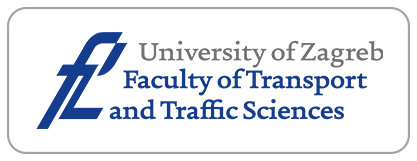Creating Infrastructure for Urban Mobility: Case Study of Skopje

Downloads
In this paper, a methodology for creating and testing new proposed transport infrastructure is presented. It is based on microscopic traffic simulation of current and forecasted traffic demand and in-depth analysis of traffic flow. The most congested boulevard in Skopje has been chosen as a use case. Real-world traffic flow data was collected and used in the calibration and validation of a microscopic simulation model. Three possible configurations of new urban mobility infrastructure have been proposed and best one chosen using appropriately defined criteria. The proposed configurations were evaluated from the aspect of traffic performances, suitability for forecasted future traffic demand, and vehicle emissions. The obtained results prove the effectiveness of the presented methodology in reducing delays and vehicle emissions and significantly improving the level of service of the chosen use case.
Downloads
Álvarez-Herranz, M., A. & Pilar Martínez-Ruiz.: Evaluating the economic and regional impact on national transport and infrastructure policies with accessibility variables, Transport, 27 (4), 2012. pp 414-427
Asensio, J., and B. Roca.: Evaluation of transport infrastructure projects beyond cost - benefit analysis. An application to Barcelona's 4th ring road, International Journal of Transport Economics, 28 (3), 2001. pp 387-403
Bham, G.H., and M. Vallati.: Slip ramp design for dedicated truck lanes using microscopic traffic simulation, Transportation Letters, 6 (4), 2014. pp 226-239
Dimitriou, H.T.: Transport Planning for Third World Cities. Routledge Revivals. Routledge. 2013
Gulhan, G., H. Ceylan, O. Baskan, and H. Ceylan.: Using Potential Accessibility Measure for Urban Public Transportation Planning: A Case Study of Denizli, Turkey, Promet - Traffic&Transportation, 26 (2), 2014. pp 129-137
Higgs, B., M. Abbas, and A. Medina.: Analysis of the Wiedemann Car Following Model over Different Speeds using Naturalistic Data." In Proc., 3rd International Conference on Road Safety and Simulation, Indianapolis, Indiana, USA 2011.
IDOM, SA.: Traffic and Transport System of the City of Skopje. Study. Spain: IDOM, SA, 2011.
Jakimavičius, M., and M. Burinskienė.: Multiple criteria assessment of a new tram line development scenario in Vilnius City public transport system, Transport, 28 (4), 2013. pp. 43-437
Author: Traffic study for the central urban area of the city of Skopje (Goce Delchev Boulevard), Book 1. Study. Bitola, Republic of Macedonia: Department for Traffic and Transport, Faculty of Technical Sciences, Sv. Kliment Ohridski University, 2014.
Mahmud, K., K. Gope, and S. M. R. Chowdhury.: Possible Causes & Solutions of Traffic Jam and Their Impact on the Economy of Dhaka City, Journal of Management and Sustainability, 2 (2), 2012. 112-135.
Midgley, P.: Improving Urban Mobility. In AITPM 2011 National Conference, Linking Communities: Growing liveability and accessibility, Melbourne, Australia 2011.
Paniati, J.: Operational solutions to traffic congestion, Public Roads, 68 (3), 2004. pp. 2-8
Rodrigue, J.-P.: The Geography of transport systems. 3rd edition. New York, USA: Routledge, 2013.
Solodkij, A., and A. Gorev.: System Approach to Elimination of Traffic Jams in Large Cities in Russia, World Applied Sciences Journal, 23 (8), 2013. pp.1112 - 1117
Trpevski, I.: Calculating emissions from road transport in Macedonia using the COPERT 4 model." Skopje, Republic of Macedonia, 2015. 10-11 Sep. Available from http://docslide.us/documents/calculating-emissions-from-road-transport-in-macedonia-using-the-copert-4-model.html.
Van Acker, V., B. Van Cauwenberge, and F. Witlox.: MaxSUMO: A New Expert Approach for Evaluating Mobility Management Projects, Promet -Traffic&Transportation, 25(3), 2013. Pp. 285-294
Šelmić, M., and D. Macura.: Model for Reducing Traffic Volume: Case Study of Belgrade, Serbia, J. Transp Eng. 140 (2), 2013
Yousekia, M., A. R. Mamdoohi, S. Moridpour, M. H. Noruzoliaee, and A. Mahpour.: A study on the generalized TFlowFuzzy O-D estimation, In Australasian Transport Research Forum 2013 Proceedings, Brisbane, Australia
Zhao, J., and W. Deng.: Fuzzy multiobjective decision support model for urban rail transit projects in China, Transport, 28 (3), 2013. pp 224 - 235




















